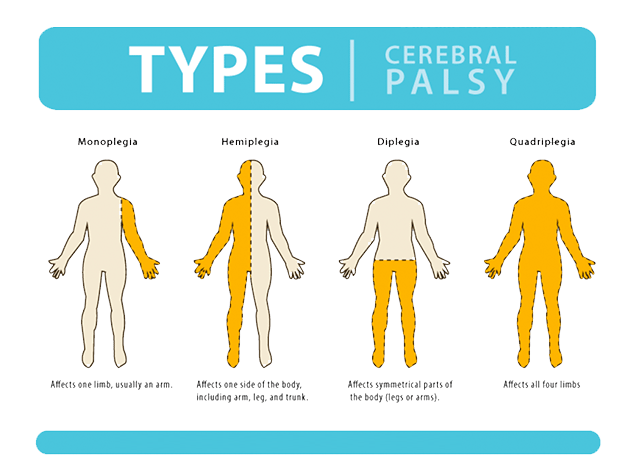
Cerebral palsy (CP) refers to a group of disorders that affect muscle movement and coordination. In many cases, vision, hearing, and sensation are also affected.
Cerebral means having to do with the brain. Palsy means weakness or problems with using the muscles. CP is caused by abnormal brain development or damage to the developing brain that affects a person’s ability to control his or her muscles.
Symptoms
Signs and symptoms can vary greatly. Movement and coordination problems associated with cerebral palsy include;
- Variations in muscle tone, such as being either too stiff or too floppy
- Stiff muscles and exaggerated reflexes (spasticity)
- Stiff muscles with normal reflexes (rigidity)
- Lack of balance and muscle coordination (ataxia)
- Tremors or involuntary movements
- Slow, writing movements
- Delays in reaching motor skills milestones, such as pushing up on arms, sitting up or crawling
- Favoring one side of the body, such as reaching with one hand or dragging a leg while crawling
- Difficulty walking, such as walking on toes, a crouched gait, a scissors-like gait with knees crossing, a wide gait or an asymmetrical gait
- Excessive drooling or problems with swallowing
- Difficulty with sucking or eating
- Delays in speech development or difficulty speaking
- Learning difficulties
- Difficulty with fine motor skills, such as buttoning clothes or picking up utensils
- Seizures
Types of Cerebral Palsy
There are different types of CP that affect various parts of the brain. Each type causes specific movement disorders. The types of CP are;
Spastic Cerebral Palsy – the most common type of CP, affecting approximately 80 percent of people with CP. it causes stiff muscles and exaggerated reflexes, making it difficult to walk. Symptoms can affect the entire body or just one side of the body.
Dyskinetic Cerebral Palsy – people with dyskinetic CP have trouble controlling their body movements. The disorder causes involuntary, abnormal movements in the arms, legs, and hands. They can make it difficult for the affected person to walk, sit, swallow, or talk.
Hypotonic Cerebral Palsy – Hypotonic CP causes diminished muscle tone and overly relaxed muscles. The arms and legs move very easily and appear floppy, like a rag doll.
Ataxic Cerebral Palsy – the least common type of CP. Ataxic CP is characterized by voluntary muscle movements that often appear disorganized, clumsy, or jerky.
Mixed Cerebral Palsy – Some people have a combination of symptoms from the different types of CP. This is called mixed CP.
Treatments
Children and adults with cerebral palsy require long-term care with a medical care team. Besides a pediatrician or physiatrist and possibly a pediatric neurologist to oversee the child’s medical care, the team might include a variety of therapists and mental health specialists.
- Medications – Medications that can lessen muscle tightness might be used to improve functional abilities, treat pain and manage complications related to spasticity or other cerebral palsy symptoms.
- Muscle or nerve injections
- Oral muscle relaxants
- Therapies – A variety of therapies play an important role in treating cerebral palsy:
- Physical therapy
- Occupational therapy
- Speech and language therapy
- Recreational therapy
- Surgical Procedures – Surgery may be needed to lessen muscle tightness or correct bone abnormalities caused by spasticity. These treatments include:
- Orthopedic surgery
- Cutting nerve fibers (selective dorsal rhizotomy)
What We Offer
We at Almurshidi Medical Tourism will find the best doctors to cater to your needs. We are partnered with a wide network of hospitals and clinics that provide top quality medical experience.
We provide free medical estimates, make medical appointments, and provide several medical opinions if needed at no cost.
Contact Us
For more information contact us at +66822004040 or via WhatsApp





